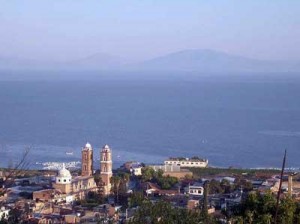 Chapala is the largest of the six Lakeside communities. The region where Lake Chapala is located was called Chimaloacán: “place for the people using shield”. In the ninth century a big migration of Nahuatl origin tribes, from the northwest of the country, gave rise to the major settlements of the central plateau of Mexico; the residents of Chapala belonged to the group of Tanalan from where a warlord named Chapa encouraged groups to form a new population on the shores of the lake. Thus was formed Chapatla or Chapatlán. The word Chapala comes from the Nahuatl and means “place of Grasshoppers on the water”. Due to the characteristics of the area, the main activities were fishing, hunting, trade and agriculture. Over the entire basin was established the first pre-Hispanic communications between Tenochtitlan and northern and western regions. Later this long basin favored the Spanish exploration and conquest. more…
Chapala is the largest of the six Lakeside communities. The region where Lake Chapala is located was called Chimaloacán: “place for the people using shield”. In the ninth century a big migration of Nahuatl origin tribes, from the northwest of the country, gave rise to the major settlements of the central plateau of Mexico; the residents of Chapala belonged to the group of Tanalan from where a warlord named Chapa encouraged groups to form a new population on the shores of the lake. Thus was formed Chapatla or Chapatlán. The word Chapala comes from the Nahuatl and means “place of Grasshoppers on the water”. Due to the characteristics of the area, the main activities were fishing, hunting, trade and agriculture. Over the entire basin was established the first pre-Hispanic communications between Tenochtitlan and northern and western regions. Later this long basin favored the Spanish exploration and conquest. more…
Tag-Archive for "Carnival"
 Mazatlan is one of the largest harbors in the Pacific coast, is located in the south of Sinaloa and is known as the Pearl of the Pacific because of the beauty of its beaches and its rich marine life. This destination combines traditional architecture of its historic center, known as Old Mazatlan, with modern hotels and restaurants of the spectacular Golden Zone, with over 20 km of beautiful beaches, ideal for surfing, diving and sport fishing of marlin and sailfish. Here tourists can find sites with natural resources and great golf courses, overlooking the sea and two marinas that offer docking and maintenance services for all types of boats. Mazatlan held cultural and sporting events such as International Golf Tournaments, the Grand International Tennis Tournament, fishing tournament Bisbee’s Billfish Classic, the Cultural Festival of Mazatlan, the Arts Festival of Sinaloa, and the Carnival, one of the most famous in the world, held in late February. more…
Mazatlan is one of the largest harbors in the Pacific coast, is located in the south of Sinaloa and is known as the Pearl of the Pacific because of the beauty of its beaches and its rich marine life. This destination combines traditional architecture of its historic center, known as Old Mazatlan, with modern hotels and restaurants of the spectacular Golden Zone, with over 20 km of beautiful beaches, ideal for surfing, diving and sport fishing of marlin and sailfish. Here tourists can find sites with natural resources and great golf courses, overlooking the sea and two marinas that offer docking and maintenance services for all types of boats. Mazatlan held cultural and sporting events such as International Golf Tournaments, the Grand International Tennis Tournament, fishing tournament Bisbee’s Billfish Classic, the Cultural Festival of Mazatlan, the Arts Festival of Sinaloa, and the Carnival, one of the most famous in the world, held in late February. more…
 It is a historic fortified city on the shores of the Gulf of Mexico in the Yucatan Peninsula. It is renowned as one of the few walled cities in America and the only one in Mexico. One of the reasons it was declared Cultural Patrimony of Humanity by UNESCO in 1999 is the excellent condition of its historical heritage. The original Mayan settlement was called KaanPeech (In Mayan language: Kaan = snake, Peech = tick, which means: the place of snakes and ticks). When the Spanish arrived, they Hispanicized it to Campeche. After their arrival, the city became the largest port of colonial America, bringing an intense commercial traffic and subsequent construction of mansions and churches. However, the same wealth that allowed it to flourish attracted the attention of pirates whose expeditions not only led to endless stories, but that led to the lifting of impregnable fortifications that distinguish today’s place. more…
It is a historic fortified city on the shores of the Gulf of Mexico in the Yucatan Peninsula. It is renowned as one of the few walled cities in America and the only one in Mexico. One of the reasons it was declared Cultural Patrimony of Humanity by UNESCO in 1999 is the excellent condition of its historical heritage. The original Mayan settlement was called KaanPeech (In Mayan language: Kaan = snake, Peech = tick, which means: the place of snakes and ticks). When the Spanish arrived, they Hispanicized it to Campeche. After their arrival, the city became the largest port of colonial America, bringing an intense commercial traffic and subsequent construction of mansions and churches. However, the same wealth that allowed it to flourish attracted the attention of pirates whose expeditions not only led to endless stories, but that led to the lifting of impregnable fortifications that distinguish today’s place. more…
